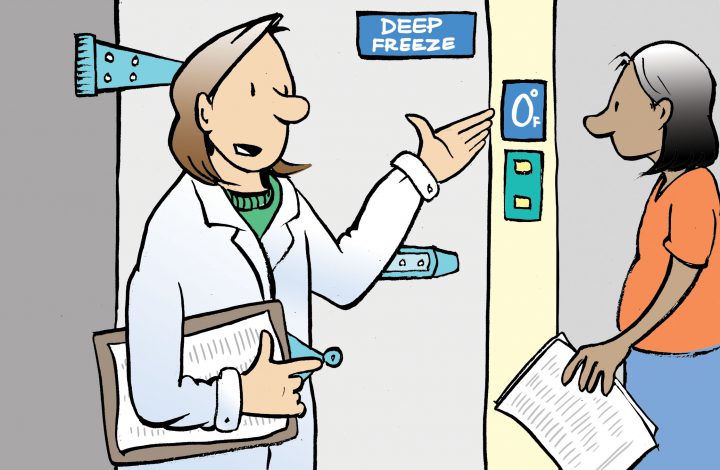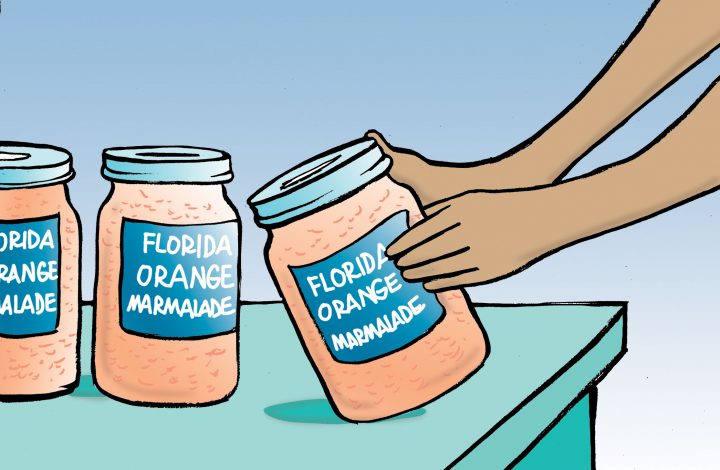Packaging & Labeling
In this guide
- Role of Food Packaging
- Packaging Material
- Weights and Measures on Food Labels
- Labels
- Nutrition
- Food Allergen Labeling
- Claims
- Packaging, Labeling and your Farmers Market Business
The type of packaging used for a specific product depends on the unique needs of the product, the business and the customer. This makes it important to identify the purpose of the packaging during the different stages of product development, because different packaging or storage may be used throughout production, processing, distribution, display, sale and consumer use of the product. The chart below describes the different roles packaging can play in food production and some common examples at Florida farmers markets:
| Role of Packaging | Description / Examples |
| Containment | Secures product during transport, distribution and display |
| Protection | Creates protection from physical, chemical, light and biological hazards |
| Communication | Provides information through labeling and branding |
| Functionality | Offers ability to microwave, pour, reseal, freeze, boil |
| Environmental | Meets consumer desires to recycle, renew resources, reuse, and biodegrade |
| Safety | Provides assurance that the package is tamper proof or tamper resistant |
A wide variety of food service packaging suppliers, both online and storefront, provide specialized food packaging that can play multiple roles such as recyclable plastic containers that protect the product from the elements, are durable enough to withstand transportation, include an integrated tamper-resistant seal, and come in colors that match the business brand. Identifying the role the packaging must play in the production, distribution, and sale of the food product makes it easier to select the type of packaging material that is most appropriate for the product.
Before purchasing materials, it is important to first determine that the packaging or container is designated for food and beverages. The Food and Drug Administration regulates all “Food Contact Surfaces (FCS),” and provides a database of products that meet FDA safety guidelines click here for the inventory of effective food contact substances.
There are a variety of packaging materials to choose from, based on the function of packaging for the product, food safety, economic considerations, and environmental concerns. Different materials such as glass, plastic, cellophane, paper, cardboard, and metal offer an array of costs and benefits in terms of appearance, storage and shelf life, transport, and food safety.
The chart below provides an outline of the costs and benefits of common food packaging materials:
| Packaging Material | Pros & Cons | Example Product |
| Paper & Cardboard | Inexpensive, biodegradable, lightweight — Not durable, degrades easily, does not protect from air and water spoilage, does not work with wet foods, cannot view product in package | Parchment paper, bags, wax paper, boxes, cartons, trays |
| Rigid plastic | Versatile for both solid and liquid foods, easy to store, can protect from air, water and UV spoilage, lighter than glass, can view product in package —- More expensive than paper, plastic is considered detrimental to the environment, may give off harmful chemicals in food | PVC bottle caps, trays, containers |
| Flexible plastic / Shrink wrap | Versatile for a variety of foods, lightweight and inexpensive, protects from air and water, can view product in package — Not durable, easily damaged, does not work with most wet foods, plastic is considered detrimental to the environment, may give off harmful chemicals in food | Bags, clingwrap, perforated bags, zip seal bags, wrappers |
| Metal | Durable, lightweight, recyclable and/or reusable, protects from water, air and UV spoilage — Expensive | Mason jar seals, twist ties, tins, cans |
| Glass | Recyclable, reusable, can view product in container, some durability, easy storage, protects from air and moisture — Expensive, heavy, breakable | Mason jars and bottles |
Many food service packaging companies will provide demonstration samples to customers to test prior to purchasing a bulk quantity. While testing the packaging, it is important to reference the Sanitation SOPs and applicable HACCP and Preventative Control plans to determine the critical food safety needs that will protect the product from hazards. Important questions to consider:
After selecting the type of packaging that will best meet the needs of the product and the business, the product must be labelled with specific information that will contribute to branding and meet feed safety criteria.
Similar to packaging, the type of labeling depends on the needs of the product, the nature of the food business and food safety guidelines. Labels may be attached as stickers or printed directly on to the product package. Labels provide an opportunity to share information with the consumer and to develop a brand with marketing logos, website and contact information, and value-adding qualities of the product such as ‘local,’ ‘handmade,’ ‘artisanal,’ etc.
Labels must also include federal- and state-mandated information that complies with food safety regulations and guidelines. There are at least three federal laws designed to ensure that food products are properly labeled. The Federal Food, Drug, and Cosmetic Act (FD&C Act), the Fair Packaging and Labeling Act, the Food Allergen Labeling And Consumer Protection Act, and the Nutrition Labeling and Education Act (NLEA), which amended the FD&C Act, provide nutrition labeling requirements.
The Food and Drug Administration (FDA) is the primary agency charged with enforcing these laws. In addition, the Florida Department of Agriculture and Consumer Services (FDACS) Weights and Measures is charged with inspecting labeled quantity claims.
The Florida Department of Agriculture and Consumer Services (FDACS) is responsible for monitoring the accuracy of commercial weighing and measuring devices to promote a fair marketplace and protect consumers. Florida Statutes (sections 531.60–531.66) require users of weighing and measuring devices to have a permit issued by FDACS prior to using the devices to label products.
Any food business that sells a product by weight is required to use an approved ‘legal-for-trade’ scale to conduct sales and label products by weight. At this time there is no charge for a state inspection of a device, and information about obtaining a permit can be found by calling (850) 921-1590.
FDACS also tests packaged goods to verify the accuracy of package labeling as it pertains to net quantity, or the number of items in a package. The agency uses the NIST Handbook 133 procedure for testing the net contents of packaged goods. For more information about using Weights and Measures at farmers markets, visit the FDACS Weights and Measures webpage.
Any food business that sells a product by weight is required to use an approved ‘legal-for-trade’ scale to conduct sales and label products by weight
The Federal Food, Drug, and Cosmetic Act requires packaged foods to bear nutrition labeling unless they qualify for an exemption, and most small food businesses fall within the exemption criteria. A few exemptions include when the business:
For more information about nutrition labeling exemptions and who needs to file for an exemption, visit the FDA website Small Business Nutrition Labeling Exemption Guidance.
Although a business may be exempt from the requirements of nutrition labeling, farmers market businesses providing nutritious food products may benefit from the value-added by including nutrition labels. It is important to note, however, that if any nutrient content claim (i.e. ‘high in iron’ or ‘sugar-free’), health claim, or other nutrition information is provided on the product label or in advertising and promotion, the small business exemption for nutrition labeling is not applicable for that product. The product will require a nutrient analysis in order to provide nutrient information on the label.
There are two ways to determine the nutrient content of a food product; refer to an online database or send a sample of the product to a laboratory for analysis. Referring to an online database is the less expensive means of developing a nutrition label, yet it is less accurate than a direct analysis and may not provide information on unique compositions of ingredients within a specialized product. There are both databases and software tools to help with your nutrition labeling. The following are links for two examples of databases for nutrition labeling:
The following are two examples of software to help with nutrition labeling:
Food testing facilities analyze food samples, and FDACS maintains testing laboratories in Tallahassee that are able to evaluate ingredients as well as chemical and biological components such as bacteria, parasites, toxins, allergens, chemical contamination, and pesticide residues as well as nutrition, food additives, fraudulent formulations, or any combination. Voluntary analysis may be costly. To learn more visit the FDACS Food Safety Laboratories webpage.
Food Allergen Labeling and Consumer Protection Act (FALCPA) helps consumers avoid the risks posed by food allergens, and the law applies to all foods regulated by the FDA except for poultry, most meats, certain egg products, and most alcoholic beverages. The law requires that labels must clearly identify the food source names of all ingredients that contain any protein derived from the eight most common food allergens: Milk, Eggs, Fish, Crustacean shellfish, Tree nuts (e.g., almonds, walnuts, pecans, coconut), Peanuts, Wheat, and Soybeans.
Except for infant formula, federal regulations do not require shelf-life, or expiration date, on food products. Yet a core principle of U.S. food law is that foods must be fit for consumption and a ‘best before’ date not only provides a courtesy to the customer, it also helps the business owner identify when a product is past its prime and should be discarded before sale.
The shelf-life of a product depends on factors like ingredients, manufacturing process, packaging, and storage conditions (temperature, light, etc.) Changing ingredients, packaging, and processing can alter the shelf-life, and it is best to have a finalized recipe and production process before conducting a shelf life test.
There are a variety of ways to date a product. Visit the following resources for methods and techniques for dating food:
The label “Organic” has become a value-added element for many food product, and the Organic Food Production Act of 1990 requires that all products marketed as organic must be certified to meet the USDA National Organic Program (NOP) standard.
The USDA authorizes third party agencies, such as Florida Organic Growers (FOG), to issue organic certificates. For additional information on registering as an organic processor or grower, visit the FOG’s Certification webpage. Consumers can also verify specific organic farms or businesses with specific ingredients or products at the USDA Organic Integrity Database
Any food product bearing a gluten-free claim must meet the requirements of the Food & Drug Administration’s gluten-free labeling rule. FDA’s 21 C.F.R. §101.91(a)(3) defines what characteristics a food has to have to bear a label that proclaims it is “gluten-free”, “without gluten”, “free of gluten”, or “no gluten” with a limit of less than 20 parts per million (ppm) in foods that carry this label.
Additionally, FDA allows manufacturers to label a food “gluten-free” if the food does not contain any of the following:
For detailed information regarding labeling, gluten levels, and compliance, visit the FDA webpages: Gluten and Food Labeling and Gluten-Free Food Labeling
The Non-GMO Project’s Product Verification Program (PVP) is a process-based and product-based program designed to assess compliance with the Non-GMO Project Standard. Their verification process is handled by independent, third-party technical administrators who determine if a product complies with their standard. For more information, visit www.nongmoproject.org.
Kosher and Halal describe what is “fit and proper” to eat for two groups of people, Jews and Muslims. Although these terms are used to describe a wide array of foods and beverages that are acceptable to eat, we will concentrate on meat.
Both of these food laws have their roots in scripture, The Holy Bible and Torah for Kosher and The Quran for Halal. We will discuss some general areas for each food law to gain a basic understanding of what each entails.
Kosher (Judaism) and Halal (Islam) refer to types of food and food processing practices that are considered acceptable according to strict religious standards. Kosher refers to foods that are proper and acceptable according to Jewish scriptures. Halal foods are foods that are allowed under Islamic dietary guidelines.
All ingredients in every product, in addition to the process of preparing the product, must be certified for strict compliance to religious guidelines and standards. For more information, visit the Kosher and Halal Meat Science page at Texas A&M University.
Proper packaging and labeling is not only a central part of meeting food safety regulatory guidelines, it can also add value and contribute to branding and marketing of a food product. although most farmers market businesses are exempt from nutritional labeling, nutritional information can add value to fresh and local products that are more nutritious that commercially processed and packaged foods from distant locales. Claims such as ‘organic,’ ‘gluten-free,’ and ‘halal’ can also add value, yet they must be verified by specific certification agencies in order to ensure the validity of the claims. Allergen labeling and product dating can promote public safety and consumer satisfaction with the product. Proper packaging protects the product and labeling provides important information for the consumer as well as the business.
For more information about topics and issues related to Packaging and Labeling, visit the Inventory, Lot-coding and Recall guide in this website.
References & Resources

State food safety regulatory agencies are responsible for supervising and enforcing federal food safety laws and regulations designed to protect public health.
Start here
Nearly every food operation legally permitted by a food safety regulatory agency in the State of Florida must prepare, process and store food in a state-permitted facility.
Start here
Florida state regulations require nearly everyone working in food service, including farmers market food businesses, to be trained in food safety.
Start here
Cleaning and sanitation play a key role in the protection of food products from contaminants.
Start here
Packaging and labeling in food service can be just as important as the product inside the container.
Start here
Even under the best circumstances, unintentional hazards can enter the food production system.
Start here